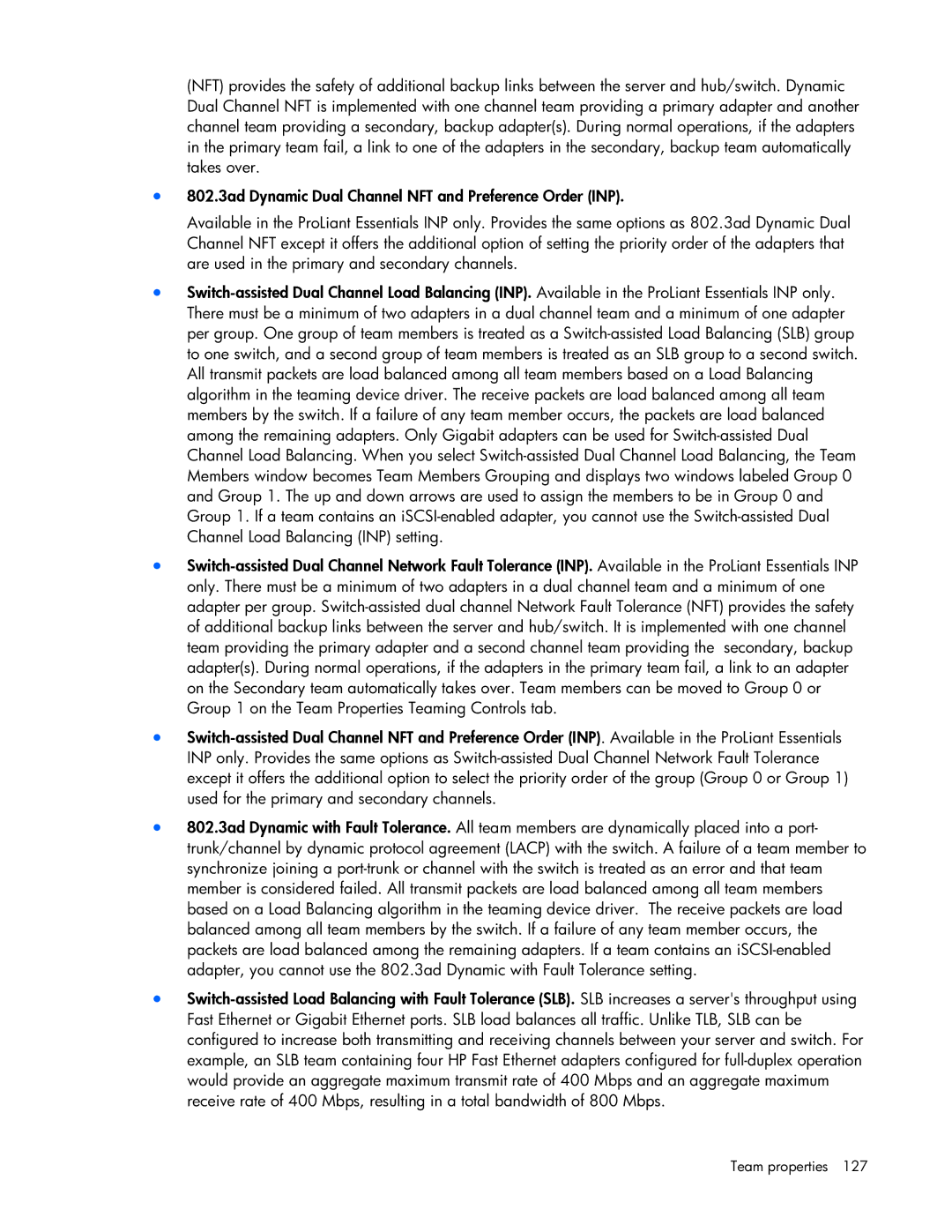(NFT) provides the safety of additional backup links between the server and hub/switch. Dynamic Dual Channel NFT is implemented with one channel team providing a primary adapter and another channel team providing a secondary, backup adapter(s). During normal operations, if the adapters in the primary team fail, a link to one of the adapters in the secondary, backup team automatically takes over.
•802.3ad Dynamic Dual Channel NFT and Preference Order (INP).
Available in the ProLiant Essentials INP only. Provides the same options as 802.3ad Dynamic Dual Channel NFT except it offers the additional option of setting the priority order of the adapters that are used in the primary and secondary channels.
•Switch-assisted Dual Channel Load Balancing (INP). Available in the ProLiant Essentials INP only. There must be a minimum of two adapters in a dual channel team and a minimum of one adapter per group. One group of team members is treated as a Switch-assisted Load Balancing (SLB) group to one switch, and a second group of team members is treated as an SLB group to a second switch. All transmit packets are load balanced among all team members based on a Load Balancing algorithm in the teaming device driver. The receive packets are load balanced among all team members by the switch. If a failure of any team member occurs, the packets are load balanced among the remaining adapters. Only Gigabit adapters can be used for Switch-assisted Dual Channel Load Balancing. When you select Switch-assisted Dual Channel Load Balancing, the Team Members window becomes Team Members Grouping and displays two windows labeled Group 0 and Group 1. The up and down arrows are used to assign the members to be in Group 0 and Group 1. If a team contains an iSCSI-enabled adapter, you cannot use the Switch-assisted Dual Channel Load Balancing (INP) setting.
•Switch-assisted Dual Channel Network Fault Tolerance (INP). Available in the ProLiant Essentials INP only. There must be a minimum of two adapters in a dual channel team and a minimum of one adapter per group. Switch-assisted dual channel Network Fault Tolerance (NFT) provides the safety of additional backup links between the server and hub/switch. It is implemented with one channel team providing the primary adapter and a second channel team providing the secondary, backup adapter(s). During normal operations, if the adapters in the primary team fail, a link to an adapter on the Secondary team automatically takes over. Team members can be moved to Group 0 or Group 1 on the Team Properties Teaming Controls tab.
•Switch-assisted Dual Channel NFT and Preference Order (INP). Available in the ProLiant Essentials INP only. Provides the same options as Switch-assisted Dual Channel Network Fault Tolerance except it offers the additional option to select the priority order of the group (Group 0 or Group 1) used for the primary and secondary channels.
•802.3ad Dynamic with Fault Tolerance. All team members are dynamically placed into a port- trunk/channel by dynamic protocol agreement (LACP) with the switch. A failure of a team member to synchronize joining a port-trunk or channel with the switch is treated as an error and that team member is considered failed. All transmit packets are load balanced among all team members based on a Load Balancing algorithm in the teaming device driver. The receive packets are load balanced among all team members by the switch. If a failure of any team member occurs, the packets are load balanced among the remaining adapters. If a team contains an iSCSI-enabled adapter, you cannot use the 802.3ad Dynamic with Fault Tolerance setting.
•Switch-assisted Load Balancing with Fault Tolerance (SLB). SLB increases a server's throughput using Fast Ethernet or Gigabit Ethernet ports. SLB load balances all traffic. Unlike TLB, SLB can be configured to increase both transmitting and receiving channels between your server and switch. For example, an SLB team containing four HP Fast Ethernet adapters configured for full-duplex operation would provide an aggregate maximum transmit rate of 400 Mbps and an aggregate maximum receive rate of 400 Mbps, resulting in a total bandwidth of 800 Mbps.
Team properties 127
